Part 21: 4000 BC - 975 BC (Setup, first & second contact, first wonder, first war)
On to game two!As I discussed, this time I’ll be trying to win as fast as possible. That means a complete shift in strategy and sometimes big ones in tactics. For one thing, I’ll actually be playing Monarchy all the way and rushing out plenty of military units quickly. I’ll also be using moves and tricks and exploits I usually won’t, like inciting revolts with Diplomats and doing partial rush-buys
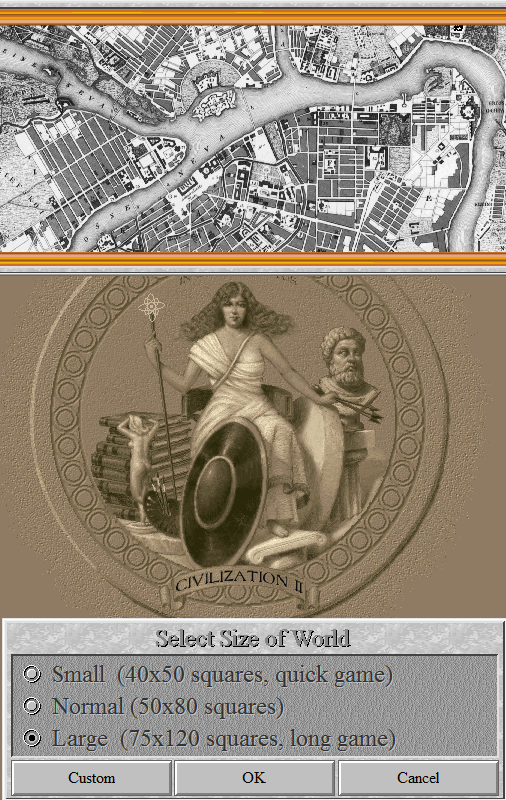
A small map is obviously much easier to win quickly than a big one, but large maps are considered standard for speed play, so that’s what I’ll go with. Note that this map will be more than four times as large as last time- and last time took millennia to explore. On large maps it can be eons before you even find another civ, let alone conquer them.
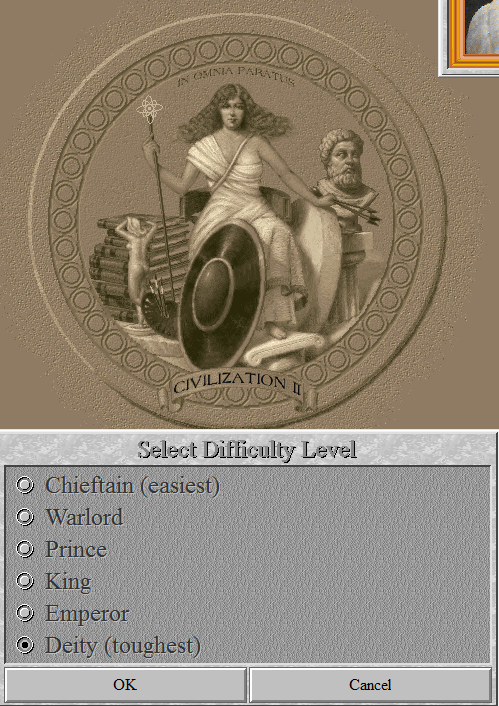
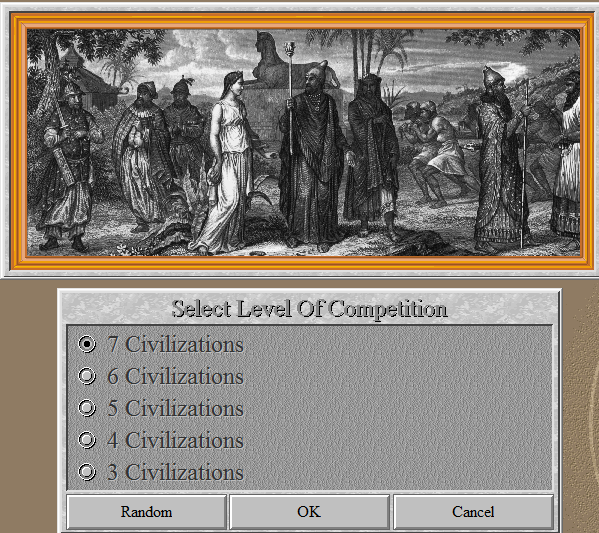
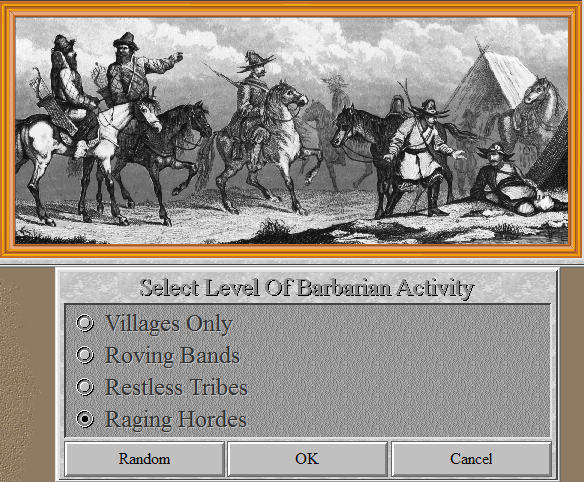
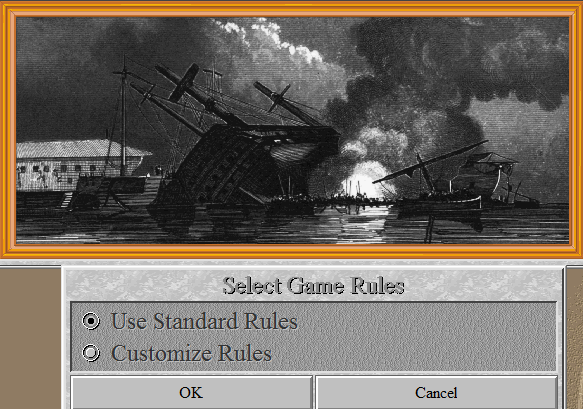
One “customize rules” option is to turn off opponents getting restarted before the year 1500 AD. If opponents keep getting restarted, it can be impossible to win before then. However, I noticed in my last several games that there have been a lot fewer restarts than I saw in the past for some reason. I’m going to take on the extra challenge and keep restarting on and see if I can actually win before 1500 anyway.
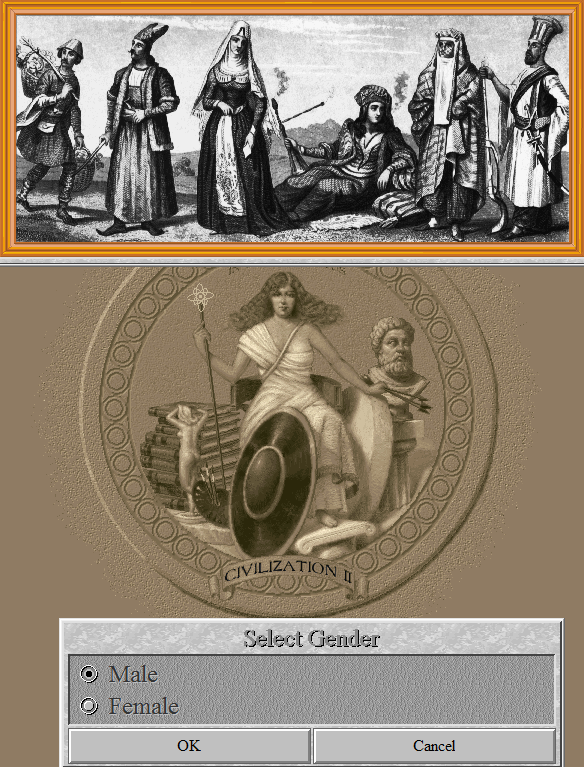

Vikings sound more appropriate for a brutal, early-medieval, Monarchy rush strategy than Romans. To stand a chance at conquering the whole world before 1500 AD they’d better have a truly epic king though.
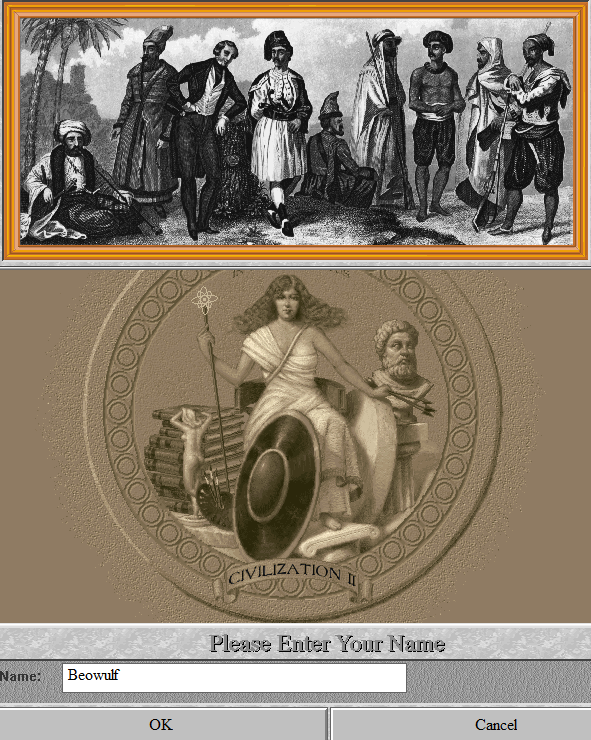
The most trusted name in kinging since 975!
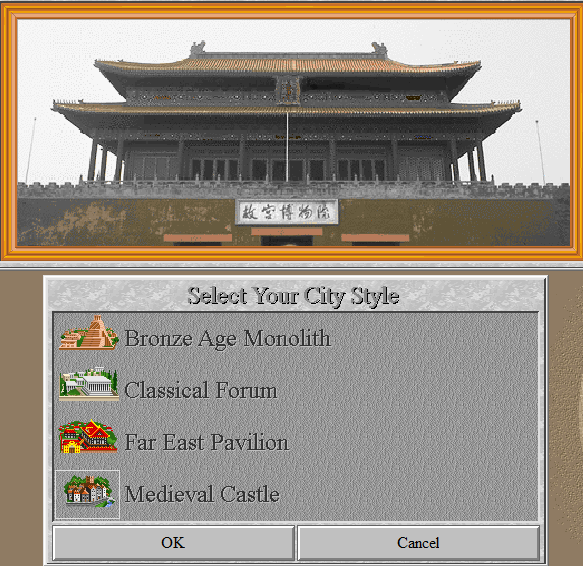
I’m almost tempted to go with Far East Pavilion just because I never see it. It’s showtime!

So. The Vikings in days gone by
And the guy who played them had tons of free techs.
…
I never heard before of a civ so well furbished
With prerequisites, useful units, and Monarchy.
Yep. This is just amazing. Let’s break that down. First of all, I’ve never even heard of actually starting with Monarchy. And in the first game in forever where I actually want to BE a Monarchy no less! I’ll transition as soon as possible, which will let my cities grow much more quickly due to eliminating the Despotism penalty.
A lot of the prereqs for Monarchy, like Alphabet and Ceremonial Burial, are also prereqs for other stuff I need, so that’s handy. And Bronze Working is pretty useless but it unlocked Currency and that’s the prereq for Trade, which I’ll need.
Of course, this could all be moot if I start off on Antarctica or something.
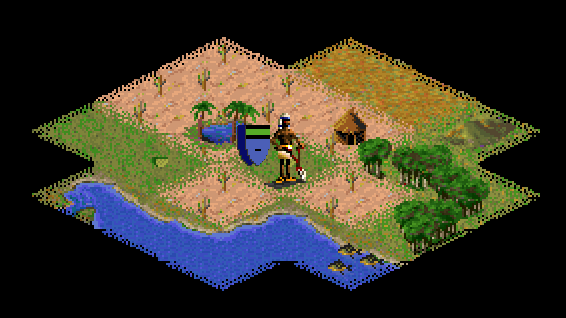
It's Deity difficulty, so I started with 2 Settlers.
What’s more, this is a great zone for the short term. A goody hut in immediate reach could be very helpful, one of my Settlers is on a Grassland already, there are some Forests for high production, and there’s 2 decent resources nearby. One of them is new: an Oasis. Oases grant a whopping +3 Food to their Desert tiles, for a total of 3/1/0. Not actually that great overall, but good. And they can benefit from Irrigation (or Mines) and Roads too.
However, it’s a MAJOR concern that there’s so much Desert around. Desert is horrible terrain and if I’m stuck on the fringe of a giant area of Desert/Plains, I could be off to a cripplingly slow start to the game. I’ll just have to explore and see.
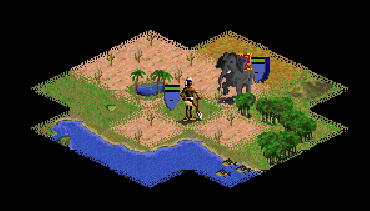
Sweet, I got a top-notch military unit from that hut. As before, I grabbed the hut before making a city so that if I got a unit, it would have free support forever.
I didn’t build any Elephants last game, but they’re quite good- basically Crusaders lite. They unlock 1 tech lower (with Polytheism instead of Monotheism) and have 4/1 stats with 2 move instead of 5/1 with 2 move. If I can find another civ quickly, I may be able to flatten them right off the bat. If not, it’s still a great scout.
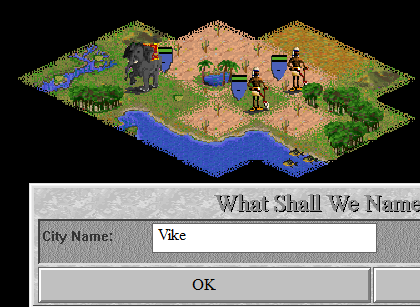
I was told in no uncertain terms last time that it was absurd to have a Roman empire without a capital called Rome.
Oh and I’d originally planned to send Settler 2 and the Elephant in different scouting directions, but the Elephant immediately uncovered a great city area, so I’ll send the Settler that way afterall. It will be a bit longer till the city is made, but it will be worth the wait to have a probably more prosperous city.
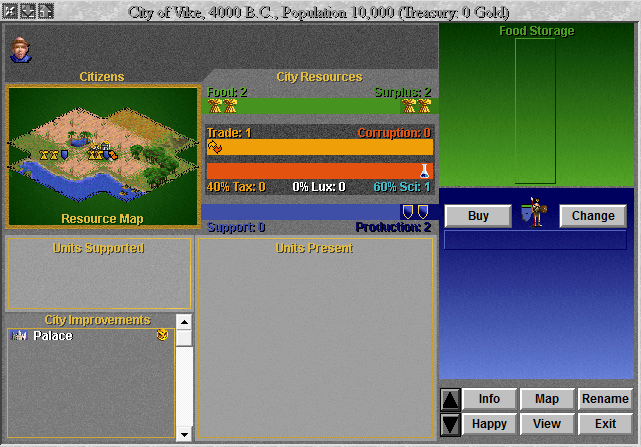
Now that I’ve covered most of the basics, I can finally start getting into real strategy talk. One of the most important things to understand about Civ 2 is that it’s all about investment and interest.
The most obvious case is the spread and growth of cities. You’ll start with 1 size 1 city usually and it takes dozens of turns to produce a Settler and build a second size 1 city. But now you’ve got 2 cities working on Settlers, so after the same number of turns you might well have 4 cities. Then 8. Then 16, 32, and so on. Your exponential growth ends only when you run into an Ocean or another civ that blocks expansion in that area. Of course, the doubling time actually shrinks because your cities grow larger and thus get more shields of Production every turn too. Even the AI will often be able to turn a starting principal of 1 Settler into a dozen size 8+ cities controlling half a continent.
Each Settler you make is an investment. You COULD have your first city just produce military units immediately and try to conquer people with that. And you COULD have your first city use maximum Production tiles instead of Food tiles and thus stay size 1 or 2 forever but start cranking out troops at the maximum immediate speed. But it’s intuitively easy to see that you can get a much more effective army if you instead invest in expanding and improving your cities first.
On the other hand, at some point it’s time to stop investing more and put the resources you’ve built up to work here and now. Most of Civ 2 strategy is about choosing well between short-term and long-term gain.
In a typical Civ 2 game, it’s a fairly good idea to emphasize short-term Science payout over long-term Science payout until you reach either Republic or Monarchy since getting out of Despotism quickly is very helpful. Working high-Production tiles to build Settlers with maximum speed is the long-term Science choice and working Trade tiles to get more Science here and now is the short-term Science choice of course. Occasionally you have a tile (like Whales, and this is why they’re so excellent early in the game) which grants both Trade and Production, but those are quite rare.
I’m in a very unusual spot in that I have Monarchy already and just need a revolution to switch to it. In fact, I have so many of the techs I need to win this game already that I barely need to worry about Science at all right now. Instead I can focus exclusively on Producing settlers with the absolute maximum possible speed.
For now, the first step is actually to make a Warrior. I can get into the ideal Settler math once that’s done.
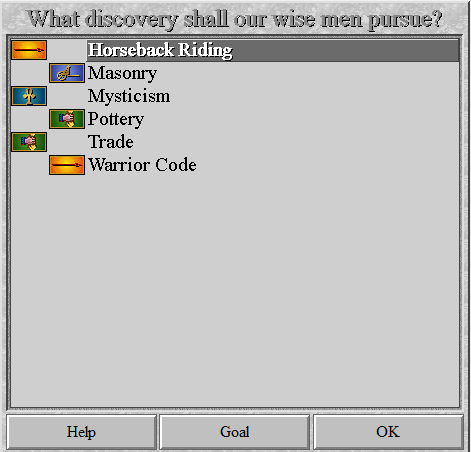
This is such an unusual technology choice to have to make early on. I’m going to need all of these except for Masonry eventually, but which should I actually focus on first?
The key techs for my strategy are Trade (To unlock Caravans), Pottery (to unlock the Hanging Gardens), Writing (to unlock Diplomats), Navigation (to unlock Caravels), Monotheism (to unlock Crusaders and Michaelangelo’s Chapel), Feudalism (to unlock Sun Tzu’s War Academy), and Theology (to unlock J.S. Bach’s Cathedral). But even if I had many of those wonders unlocked now, I couldn’t really start building them any time soon. Same with Caravans.
Really, the only techs that it would benefit me to acquire promptly are Philosophy (so I can get the free bonus tech by learning it first) and Horseback Riding (because Horsemen are THE most cost-effective scout and barbarian defense right now). And of those two, Horseback Riding gives the biggest quick payout. I’ll go for that.
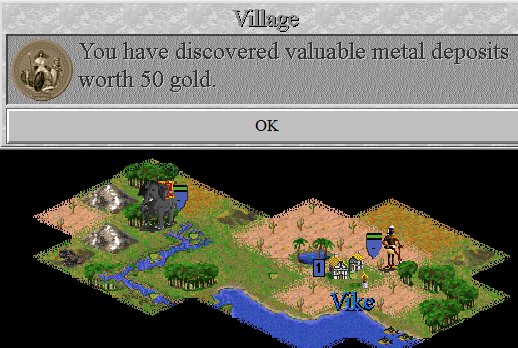
Found a bit of gold in a village. That’s nice for barbarian insurance mainly.
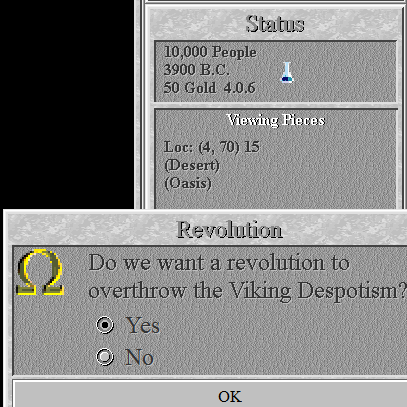
3850 is the first OEDO year, so 3900 is the turn to have my revolution to minimize the amount of Anarchy (and thus wasted Science).
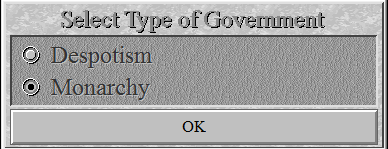
Tough choice.
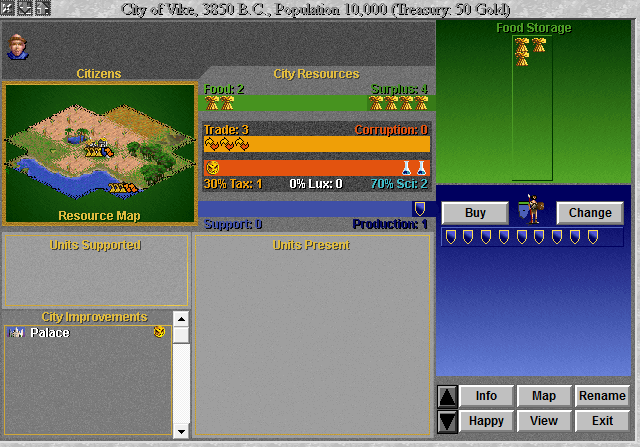
In a previous post I mentioned that a unit appears on the turn that the production box fills and that any extra shields are wasted. My Warrior only needs 1 more shield, so by switching the worked tile to this Fish I can score some bonus Science without impairing my Production rate at all.
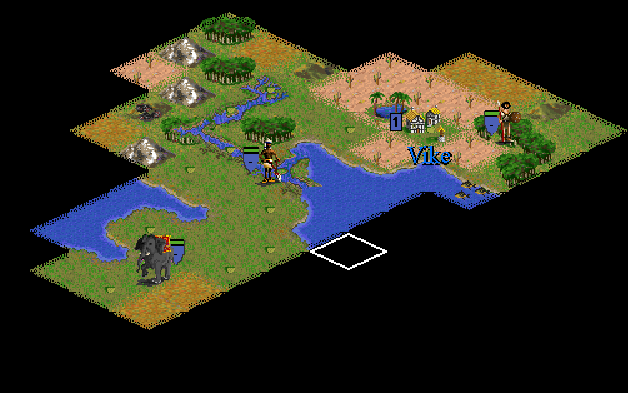
So in the year 3800 (turn 5), I’ve got my first Warrior and my Elephant out scouting and my second Settler ready to build.
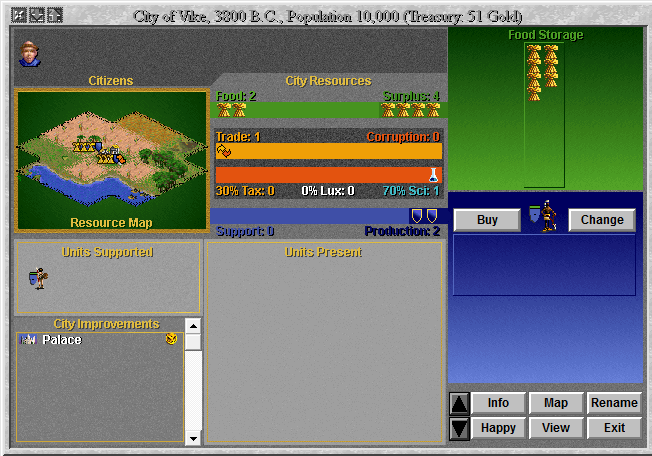
Math time! Making a Settler takes 40 shields. What’s the fastest way to achieve that? Well if you know all the rules, that’s just a complicated algebra problem.
The question basically amounts to “can you build the Settler faster if you grow first and THEN maximize Production with all your citizens or are you better off maximizing Production right now?”
Now Forests grant 1/2 Food/Production and the Oasis now gives 3/1 and my base Grassland gives 3/1. The Fish grant 3/0, which for this purpose is strictly worse than the Oasis. The Plains and Deserts and Hill and Ocean are likewise not worth considering.
My city will grow on the turn AFTER the Food box fills, but the Settler will be built on the same turn the Production box fills. It will take 13 more Food to fill the Food box and 40 more shields to fill the Production box.
If I start working the Forest immediately (getting 3 shields per turn), I’ll get a Food surplus of 2 per turn. Thus it will be 7 turns before the Food box fills. In that time I’ll get a total of 21 shields. Then I can work 2 Forests for a total of 5 shields per turn. So it will take 4 more turns to hit 40. There’s no benefit to overfilling the Production box, so I could switch one of those Forest tiles out with the Oasis for 1 turn to score 2 extra Food. Thus 11 turns total, finishing with a total of 7 or so Food in the food box toward hitting size 2 again.
If I start working the Oasis immediately, I get 2 shields per turn and things are a bit more complicated. See, I get a Food surplus of 4 per turn, so after 3 turns I’ll have 19/20 Food needed. There’s no benefit to overfilling the Food box, so on the 4th turn I could get a free Production shield by switching to work a Forest instead. That makes a total of 9 shields before growth. Then 5 shields per turn from working 2 Forests, so 7 turns to finish. But because there’s no benefit to overfilling the Production box, I could spend 2 of those turns with 1 guy working a Fish tile for extra Science and gold (and a bit of Food) or 4 of those turns working the Oasis and a Forest for maximum extra food. Thus 11 turns total, finishing with 15 or so food in the food box.
Thus I get the Settler in the same number of turns, but working the Oasis will give me a significant boost toward being able to produce my NEXT Settler faster or whatever else I want to do. It’s a superior strategy except for one possible consideration: scouting.
My Warrior must walk back into this city on the turn the Food box is full to prevent Civil Disorder upon growth. I can spend the time up until then scouting, so I can scout more with the first strategy. Still, moving for faster Production of Settler 2 is probably better. That’s what I’ll go with.
Now I glossed over a few minor factors here to simplify the calculations and this was a relatively easy problem since there weren’t many useful tiles to choose from, but in principle basically every Civ 2 tile working decision can and should be figured out like this. It’s probably not worth bothering with the details except in the case of wonders and Settlers though, since getting those out with maximum speed really has huge benefit.

Second city time. This is a fabulous spot; a rivered Grassland with access to all the other Grasslands (with and without Rivers) that I could ever want. Plus a couple of Forests, one of which even has a River.
Oh and I’ve keeping my Elephant going that direction since I’m seeing mostly good terrain there but mostly plains and deserts north of my starting zone. It’s good to focus on scouting areas you actually want to move into, though of course I will need to check the other directions eventually.
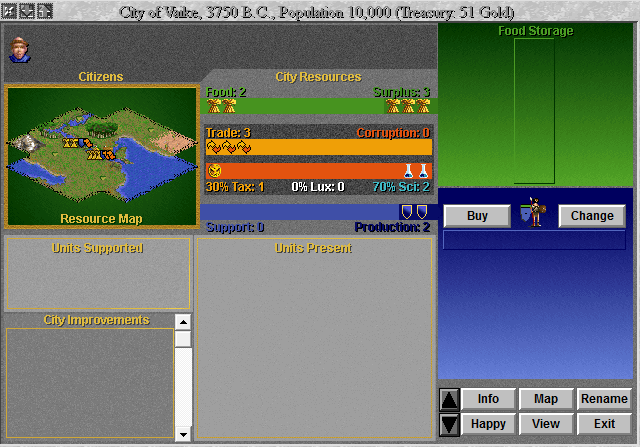
Time for another Production optimization problem. Now the goal is the same but this time I’m not skipping the step of deciding to first build a Warrior.
To be maximally efficient while not building a Warrior (basically what I did last game), I need to get 40 shields the turn after I get 20 Food. Otherwise I have to endure at least 1 turn of Civil Disorder or using an Entertainer, which is inefficient.
Working the rivered Forest would give 2 surplus Food and 3 shields per turn, so I’d grow significantly too fast. Working a deliberately terrible tile like a Mountain for a while would give me 2 surplus shields and 1 surplus Good per turn. The ‘best’ strategy to get out the Settler would be to work the Forest for 1 turn and then the Mountain for 18. That would give me 20 Food and 39 Production, so the city would grow and then immediately produce the Settler on turn 20. But that outcome sucks!
Suppose I instead built a Warrior, grew to size 2 at some point, and then built the Settler? Well there’s basically two options: first working the rivered Grassland then both Forests or first working the rivered Forest then both Forests.
With the Grassland method, the Warrior would finish on turn 5- with 15 wheat bundles in the box. I could switch to work the Forest for an extra free shield for one of the remaining 2 turns, so the city would grow after turn 7. At that point it would have a total of 5 shields toward the settler. Working both Forests would give 5 per turn, thus in 7 more turns the Settler would finish. Total of 14 turns, ending with 7 Food or so in the Food box. 7 tile-turns were spent working a tile that didn’t give any Trade, so 7 Science beakers were given up.
With the Forest method it would actually be best to work the rivered Grassland for 2 turns. The Warrior would then finish on turn 4 with 10 wheat in the box. So the city would grow in 5 more turns (after turn 9). It would have 15 shields in the box, so it would take 5 more turns to make the Settler. Turn 14. But with only 5 Food in the box and only 5 Science beakers given up.
Both of these outcomes are roughly equivalent (which isn’t always the case), but they’re both MUCH better than the no-Warrior, no-growth till the last second method that I used last time. Was I playing badly then?
Well, no. See the big difference is that I was still a Despotism last time. Now I’m a Monarchy. Under a Monarchy, I actually get to benefit from the free Irrigation on all city tiles. So that’s +1 Food every turn, which makes rapid growth both inevitable and a much better strategy. As a Despotism with this city I could grow and immediately produce the Settler after turn 16 with no Warrior. With a Warrior and speedier growth strategy it would take an extra turn. Plus, unlike in this game, those Warriors would go on to become less than useless when I switched to Republic.
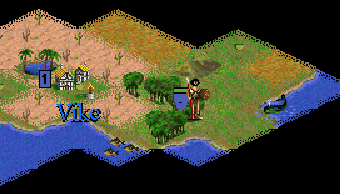
Well the Warrior heading east found another nice spot. Since I’m choosing the fast-growth, low-exploration time option, he’s got to head back now.
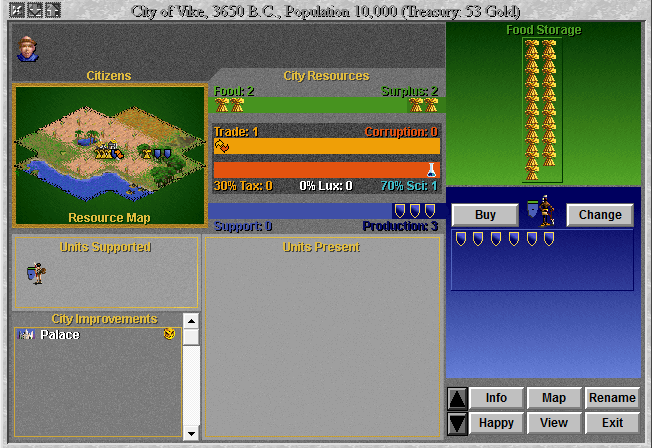
Once again, there’s no benefit from overfilling the Food box, so I switch from the Oasis to the Forest to score an extra shield this turn. Check all your cities every turn so you can take advantage of such opportunities to get extra Trade or Shields or Food when one box is about to fill up. The little advantages can add up- and sometimes you can do things like get a Settler out a whole turn earlier.
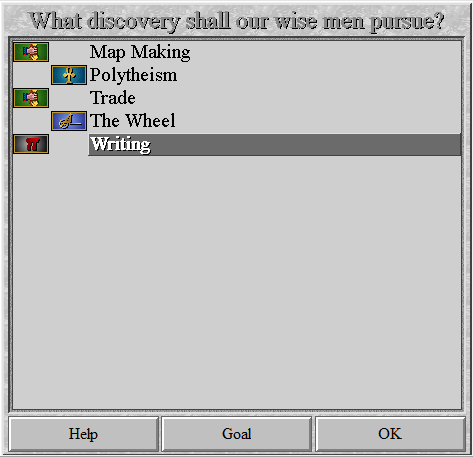
Now that I have Horseback Riding, it’s time to start moving toward Philosophy. Writing will do.

This… looks like a terrible city spot with good spots right nearby. Oh well. At least I can build Settlers who can go to good spots instead out here.
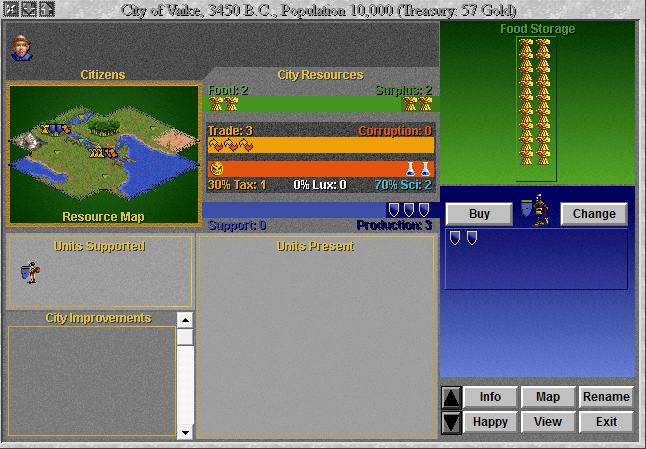
Food box perfection due to my planning.
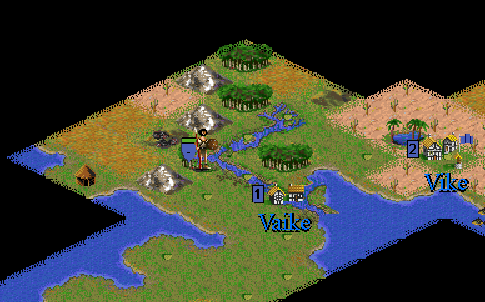
My Warrior found a hut, but I didn’t have time to claim it since I had to run back to prevent disorder. That’s important. Most things I could get out of a hut (like gold or a tech I won’t use for 50 turns) won’t actually be much less helpful in a few turns when I can send this guy out again once the city shrinks back down.
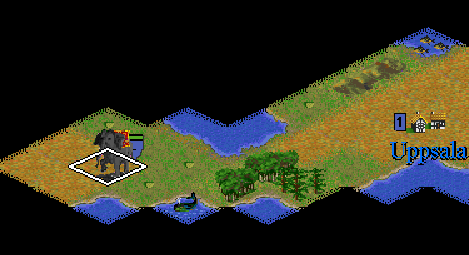
Still just exploring. There seems to be one really, really long strip of land to this continent. Maybe it’ll expand out into a bigger landmass at some point. Or maybe it will narrow down and turn out to be an island. I hope not.
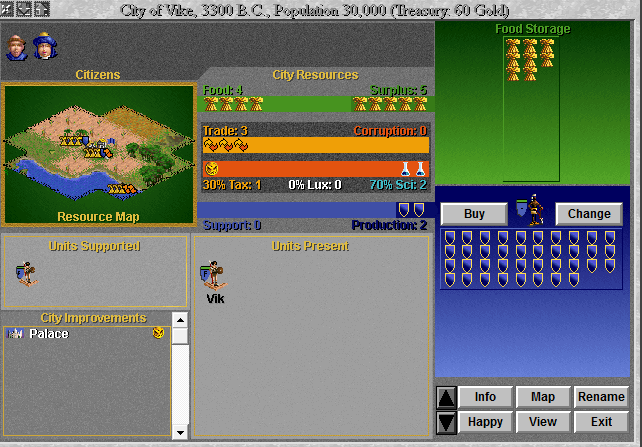
Again, city micro here gets me bonus Food and Science with no loss in Production speed.
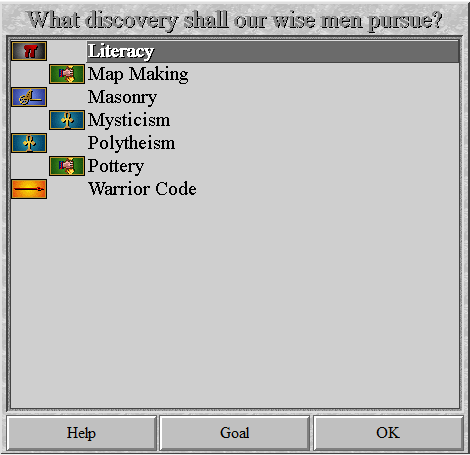
Both Mysticism and Literacy are Philosophy prereqs, why not go for Mysticism? Well because Mysticism was unlocked but not offered last time. That means it will be offered this time and next time but then not offered again the time after that. So I can definitely take it next time. But Literacy I don’t know the pattern for yet. If I don’t take it this time, maybe it won’t be available next time. That would slow me down.

Awesome! This is a great-looking general area for a city. And the landmass I’ve been exploring is so enormous that I can really settle it MUCH faster if I get some cities out here immediately.
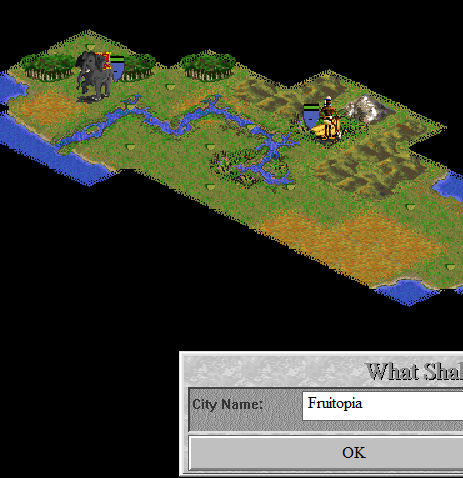
Great new resource! And a great city site with another great one nearby, perfect. Fruit gives a sweet +3 Food and +1 Trade to the Jungle tile its on, for a total of 4/0/1. I’ll build right on the Fruit tile to make it give an extra Production.
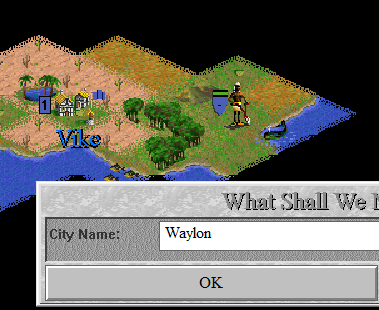
Why didn’t I build 1 south of here? Well that’s what I would have done in the last game where I was 1) trying to pack in as many cities in a small area as possible and 2) planning on using maximum total Ocean tiles. Here I’m still playing smallpoxish, but I’ve got such a vast land area that an extra city here or there can’t make much difference and I don’t plan on using the Oceans much, so having access to more Grasslands is important.
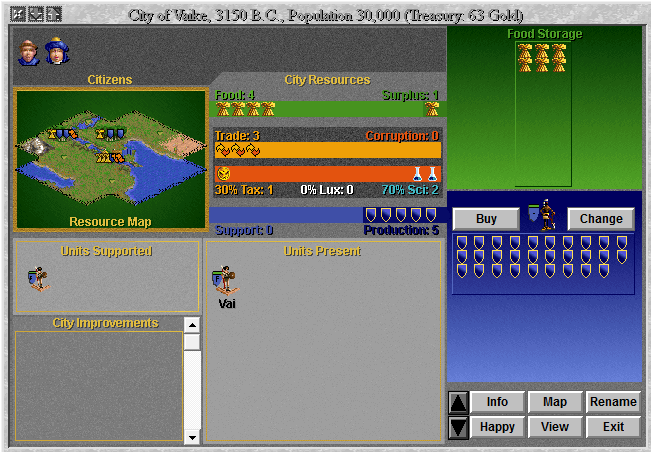
Watch this!
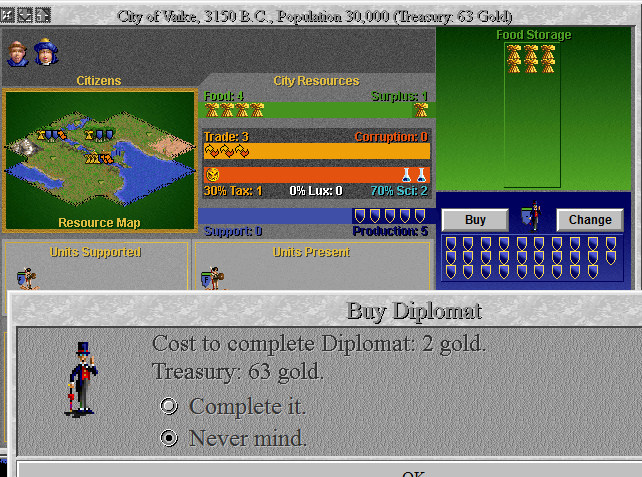
It’s cheap because there’s only 1 shield left to build the Diplomat.
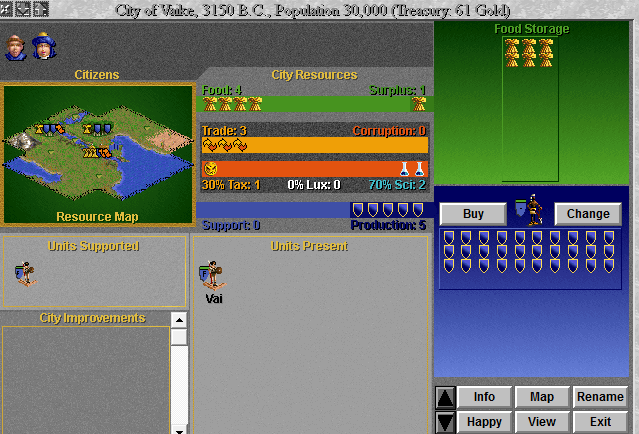
And now there’s 10 shields left instead of 11, so with 5 Production the Settler will finish a whole turn early with 0 wasted shields instead of 4! For a price of 2 gold.
This trick is the general case of “partial rush buying” and works most efficiently when 1) you’ve unlocked at least 1 20 shield unit (like Horsemen or a Phalanx) and one 30 shield unit (like Diplomats and Archers). If you don’t meet that condition, you often can’t do the trick. 2) Paying to complete the current line of 10 shields would leave a number left that’s an even multiple of your city’s production per turn. 3) Your city isn’t about to grow or otherwise end up with more or less production per turn. 4) Your city doesn’t have unworked tiles around that would just grant an extra shield or two of Production on the turns you needed it.
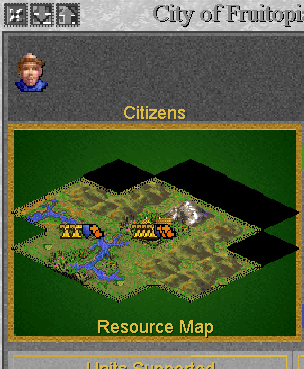
Something strange is going on here. See that Fruit tile with the city on it? It SHOULD only give 1 Trade according to the terrain tiles descriptions in the help menu. And that’s due to the Fruit; Jungles normally give none. Now it doesn’t actually have a River on it, I checked that. And it does have a Road, but Roads are only supposed to grant +1 Trade on Plains, Grasslands, and Deserts. They definitely do not on Jungles. What gives?
Well I did a whole bunch of tests and I found out that, once again, the help menu is full of lies and omissions. It turns out that Roads DO grant +1 Trade on a few tiles other than Grasslands, Plains, and Deserts. Specifically, Roads also grant +1 Trade on any special resource tile which grants extra Trade already. Thus Wine Hills without Roads grant 4 Trade instead of 0, but Wine Hills with Roads grant 5. Coal Hills with or without Roads give 0 Trade. Fruit Jungles with Roads give 2 Trade instead of 1, but building Roads on regular Jungles does nothing.
This doesn’t really change much since all of those tiles are rare and good already, but I guess it does mean you should remember to build Roads on them at some point and it also makes it slightly more desirable to found a city right on one since cities grant free Roads.
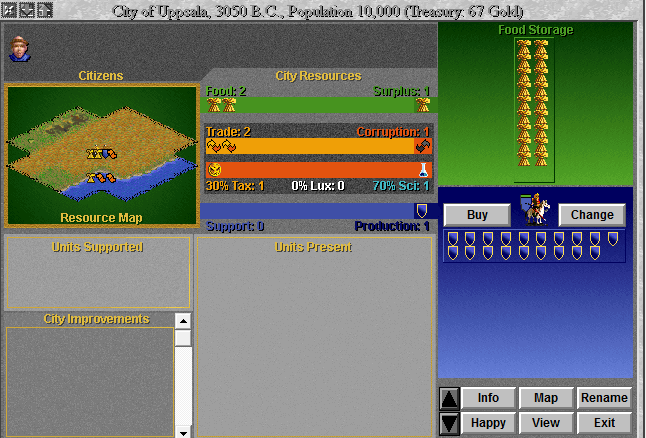
I’m going with a Horseman instead of a Warrior in most far-flung cities because I’ll have a really hard time defending them- or recapturing them- with anything less.
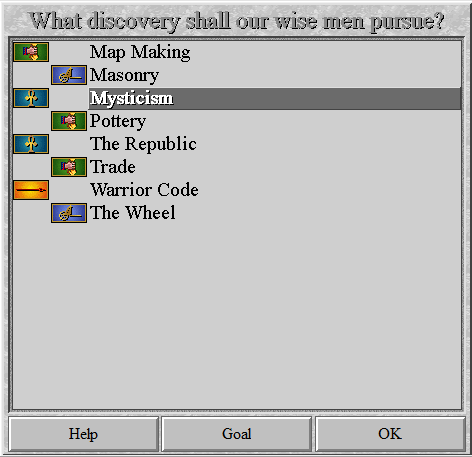
Mysticism time, as I discussed before. Man, it feels so weird to be passing up The Republic.

I sent a Settler out to claim this hut and then probably found a village here, but this second Settler changes things. What I think I’m going to do instead is start building masses of Roads, because I really need to get my empire connected. A big reason for that is that the terrain around here seems pretty bad.
A lot of Civ 2 guides say that you should never use ‘wandering nomads’ to found cities and should instead have them exclusively make Irrigation and Roads, but that’s poor advice.
It’s true that they have free support forever, and that’s nice. It’s particularly nice as an early Republic since Settlers for them cost 2 Food and 1 Production per turn and they don’t have much of either to spare. As a Monarchy it helps considerably less.
The bigger issue is that another city here and now- often in an area it would take you a thousand years to naturally walk a Settler into- is worth a lot more than a bit of Irrigation and a few Roads built up over hundreds of turns. That city will produce more cities and those cities will eventually be able to support many Settlers. Never, under any circumstances, do something as terrible as to use a second starting Settler to Irrigate.
If it’s fairly late in the game and you already have all the cities you need nearby, then it may well be worth keeping the nomads around to improve terrain for you, but otherwise build more cities promptly. I’m in the situation of having just about all the cities I need nearby though and I have a pressing need to get more Roads, so I’ll have this free Settler get to work on those.

The Elephant is still scouting. This is definitely a whole continent, not just a big island. And I definitely need more scouts.
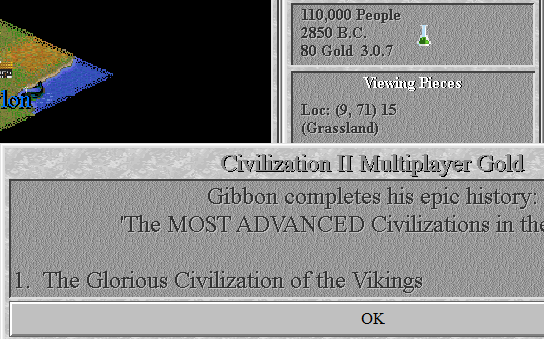
Not a surprise since I started with a bajillion free techs.
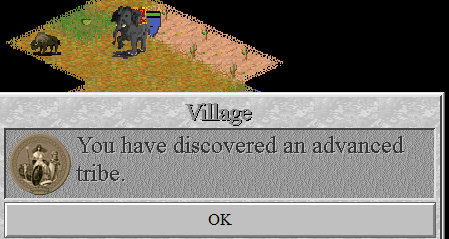
Nice. I’m definitely glad to have another city way out here. That will make it much easier to build more cities across the rest of this huge, empty continent. It would take like a hundred turns to walk them here from the capital zone.
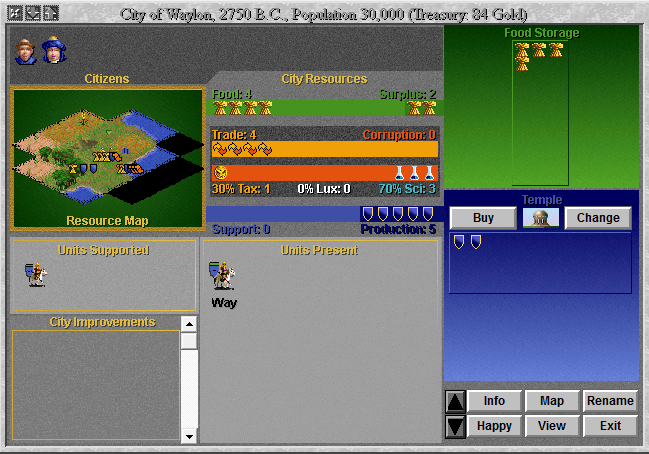
So I did a bit of scouting around Waylon and realized that it’s a remarkably good place to start building wonders. The reason is the Whale and the Wheat. Both of those tiles give plenty of Food, but also some Production. That will make it easy to rapidly grow the city to massive size while still making progress on a big project. Then I can use all the Forests and maybe a Mine too to amp the production up seriously high. Step 1 is to make a Temple so I can keep the city happy at a much bigger size.
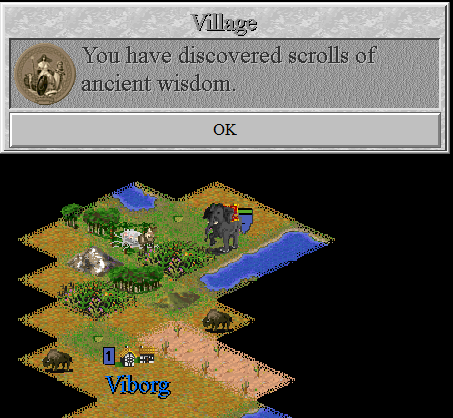
I really do need more scouts quickly, but there’s not much I can do about that since I also need tons of Settlers and the like.
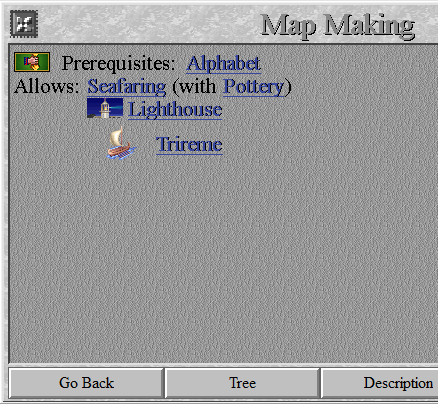
Well that’s a useless tech to get, oh well.
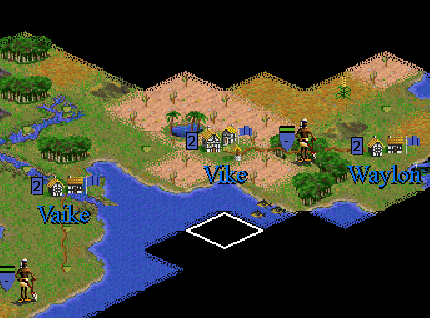
The beginnings of a truly epic road…
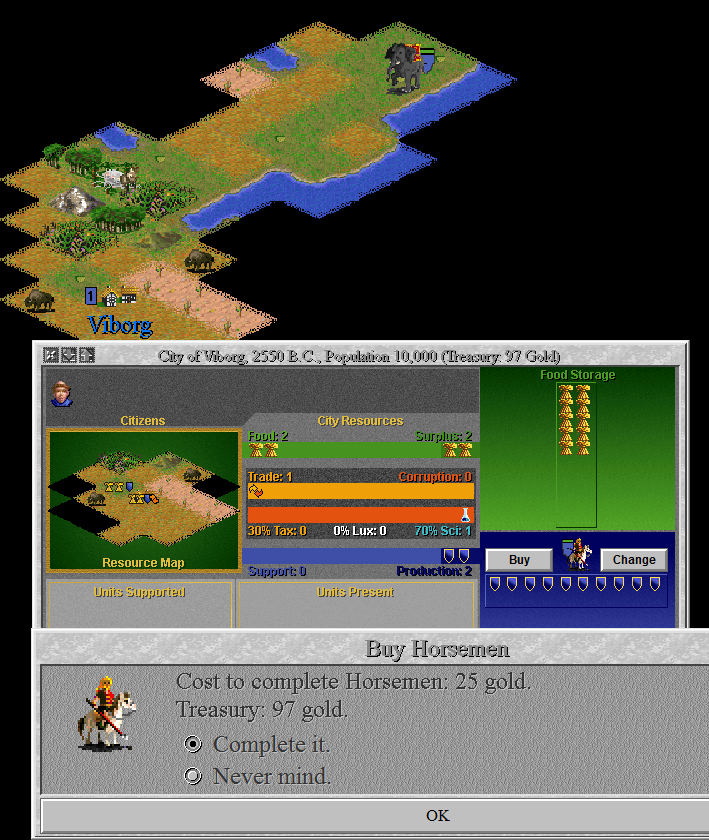
Alright, this is what I can do. I can buy this Horseman early, send him out exploring, and still have time to complete a Warrior to hold down disorder by the time the city grows. Being able to reveal the map twice as fast is well worth 25 gold.
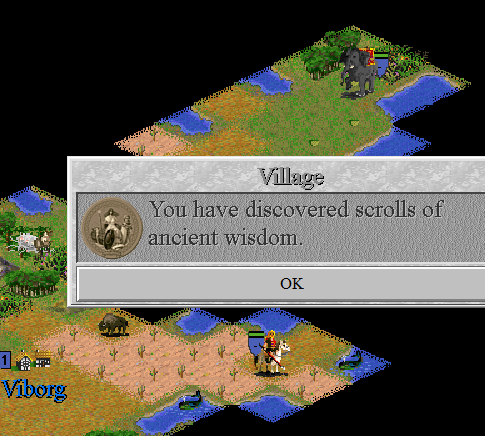
It would have been sweet to find more Horsemen, Charioteers, or Elephants in some of these places, but oh well. I’ve had great luck all in all.
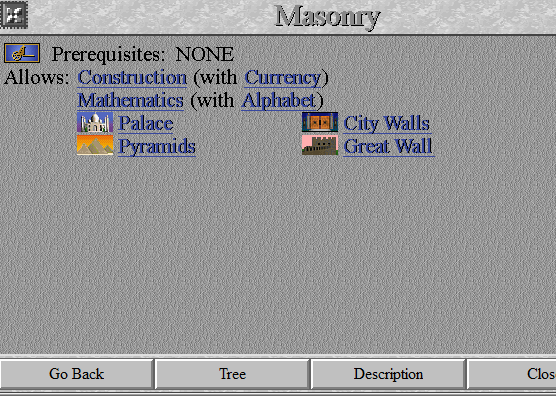
Alas, I got the 2 techs I needed least. Pyramids is actually a sweet wonder for a non-celebration player, but I need too many other wonders more.
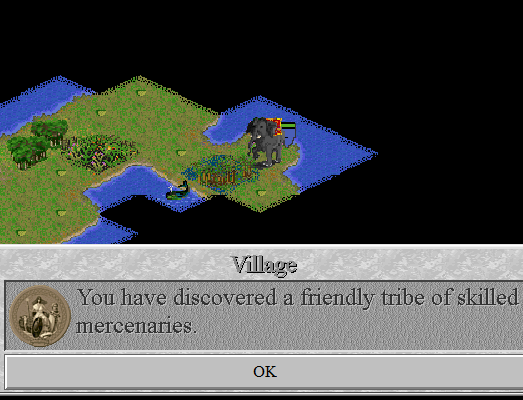
Here we go! Sadly I found them in a dead end area.
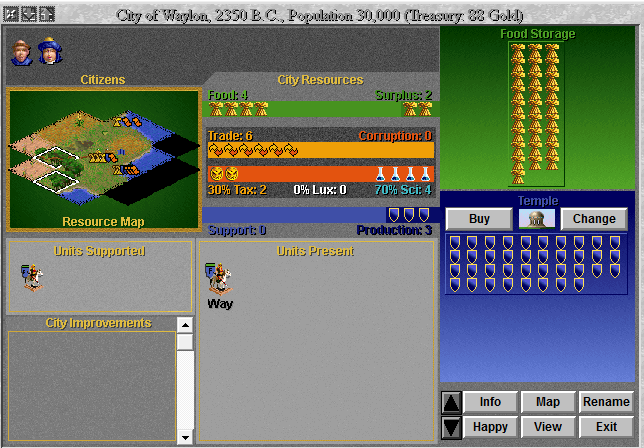
Just a bit more city micro to net some bonus gold and Science without slowing either growth or Production.
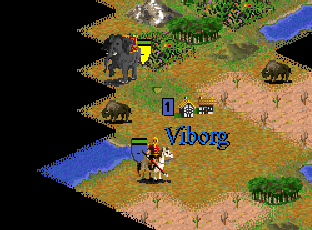
Contact! This is bad though, that guy could wreck my city. I can counter-kill him, but the city will still be destroyed.
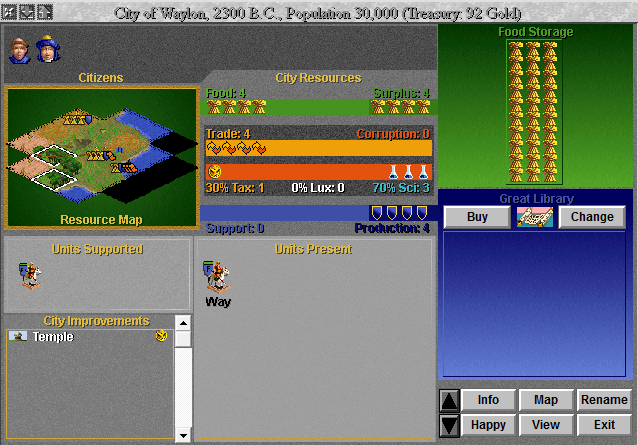
Waylon gets to work. This isn’t actually the wonder I want, but it will be a good placeholder until I unlock that one.
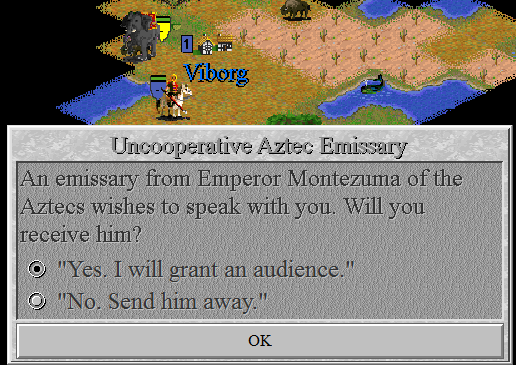
Uncooperative, bad sign. I’ll need to be pretty darned conciliatory in these negotiations; I can’t afford to lose that city.
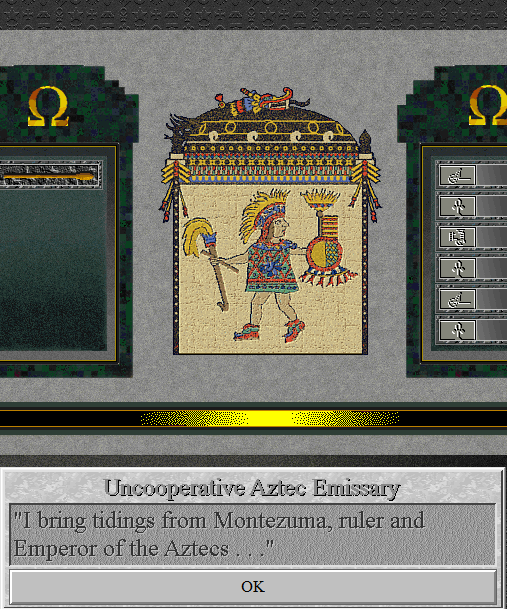
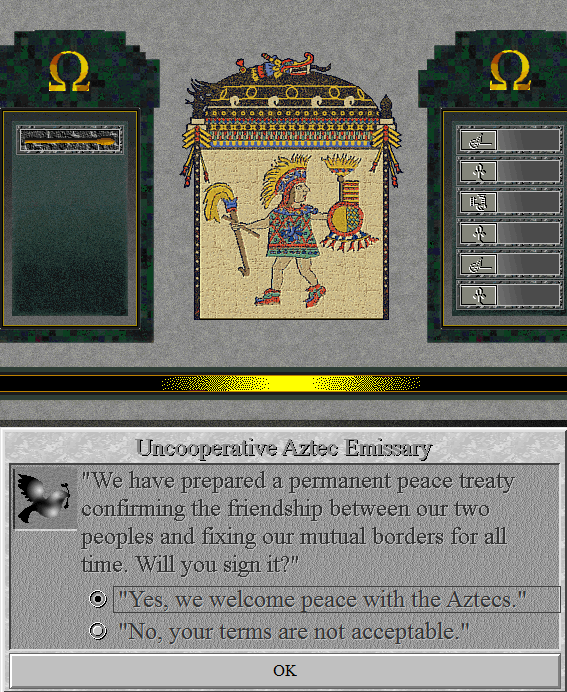
Phew, all is well. Most Civs will offer peace the first time. The Greeks last game were a really weird exception.
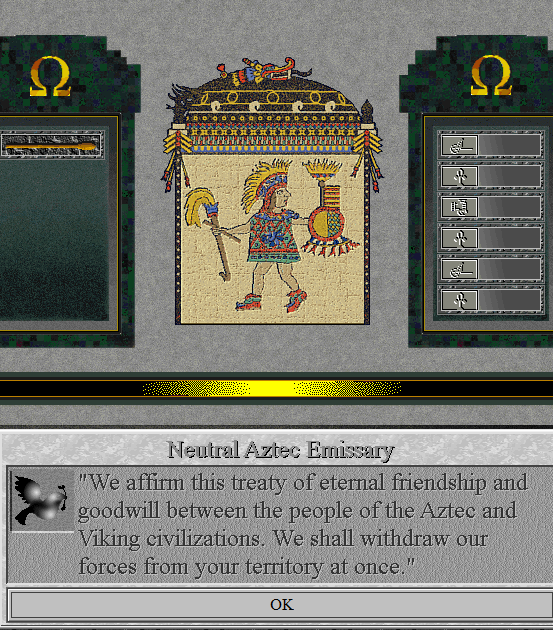
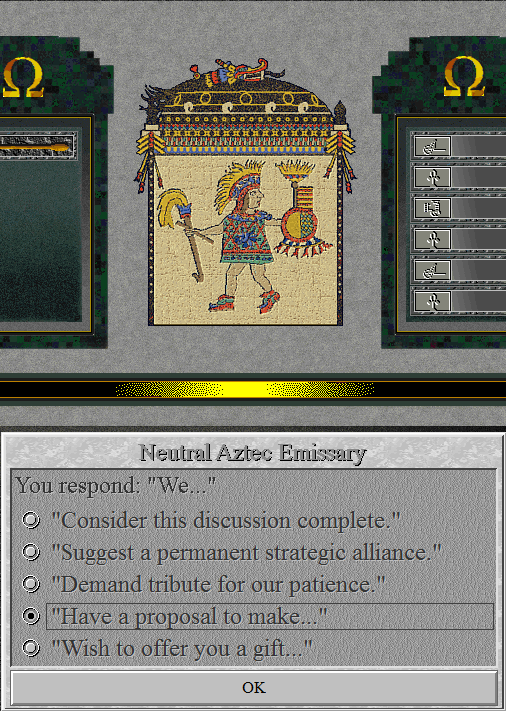
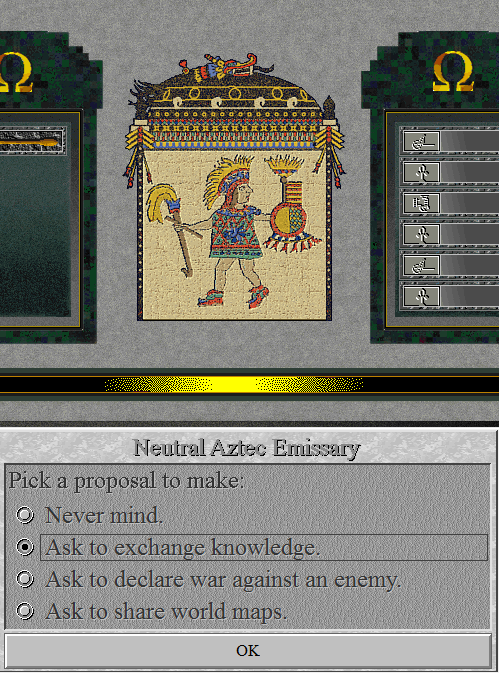
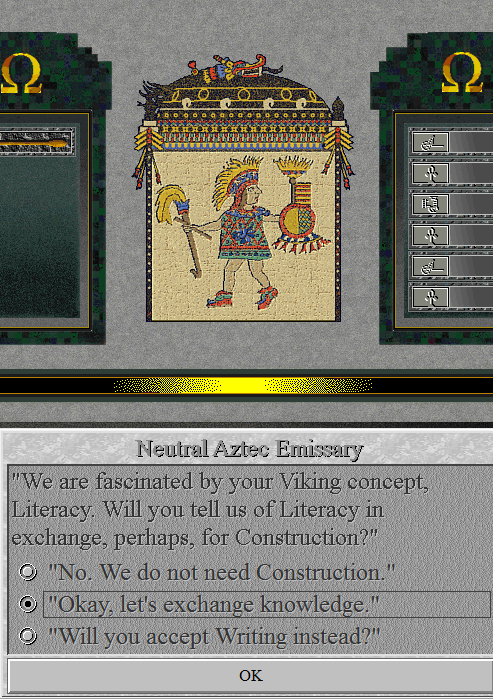
I’m a little hesitant to give Literacy since they could get The Republic or the Great Library with it, but whatever.
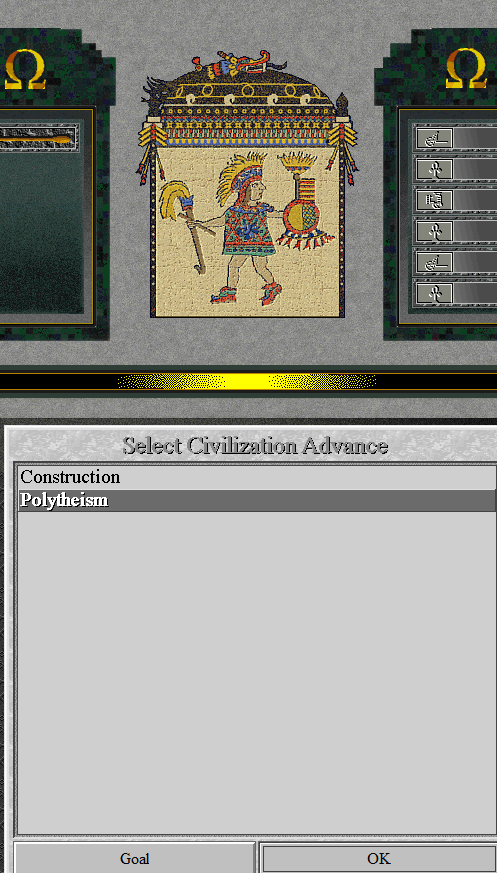
Huh. They’re surprisingly advanced in the religion tech line. I guess they built those Elephants themselves.
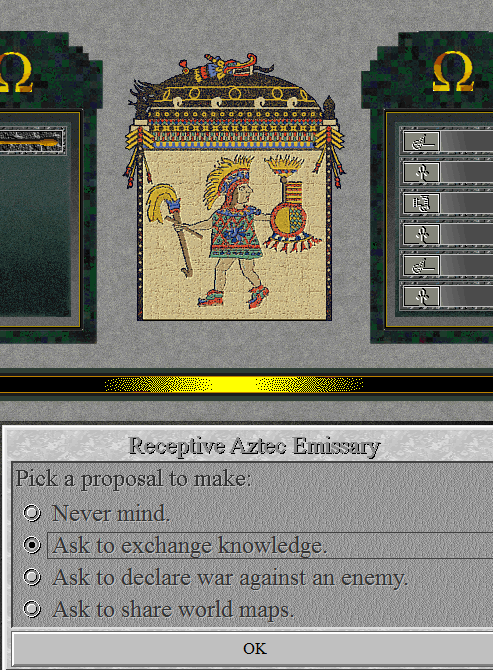

I don’t actually want Construction, but I do want to get them friendly.
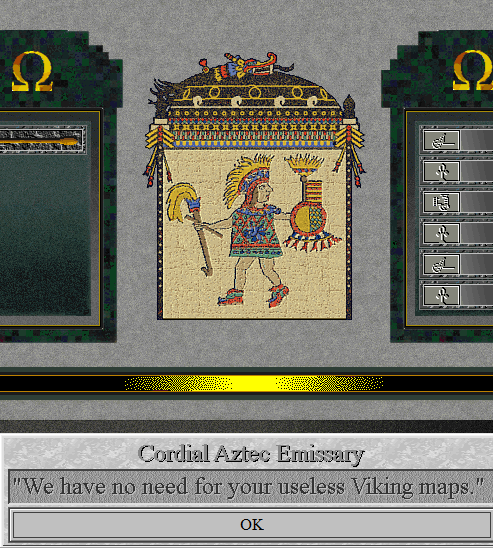
Didn’t actually help, but was worth a try.
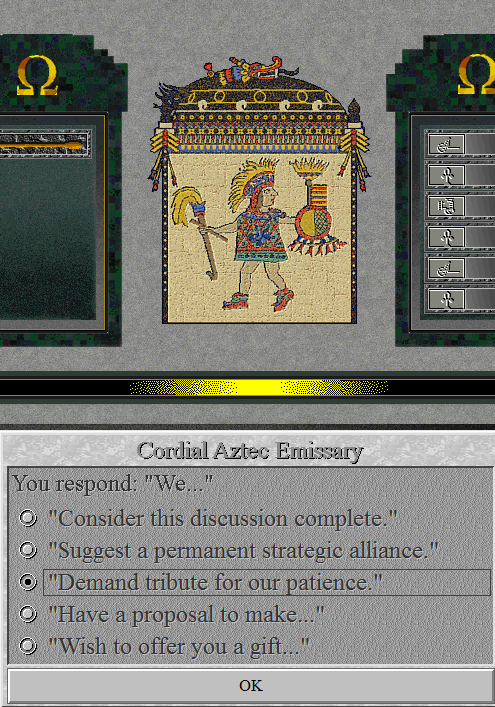
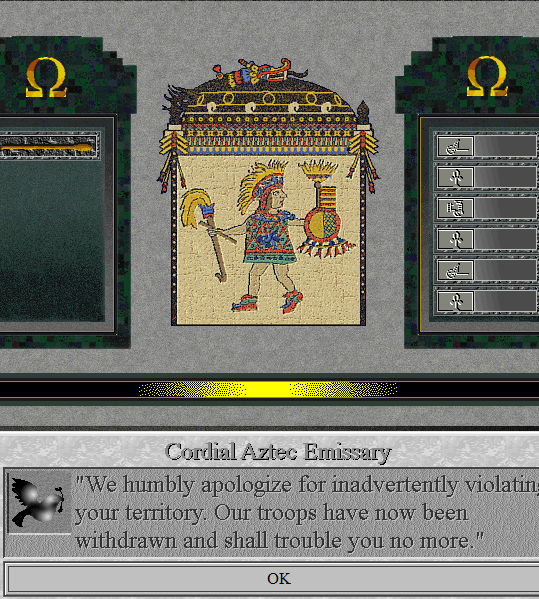
… you already said you would. I want gold!
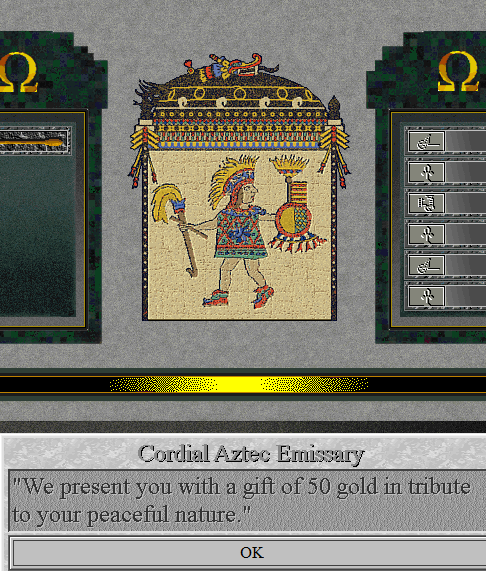
Oh, ok.
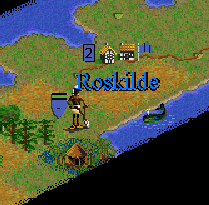
WHALES!

Darn, it turns out to be an Archer and we’re dozens of turns from anywhere to scout.
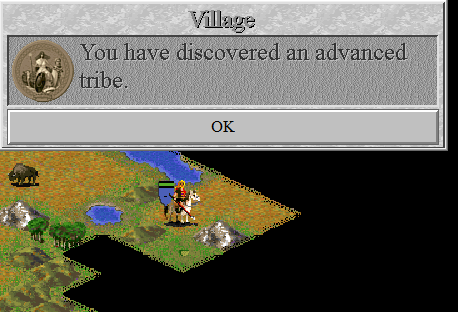
I’m really glad to be getting all these cities… but they’re almost all in just awful areas.
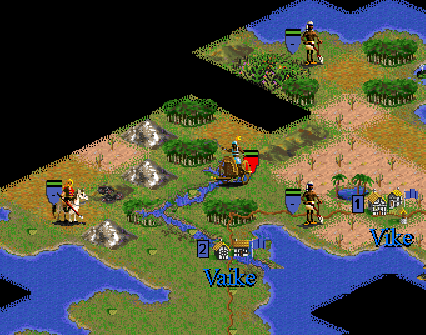
Geez, I didn’t even get a warning message about these guys. That’s a unit type I don’t think was ever seen last game; Charioteers. They’re between Horsemen and Elephants at 3/1 with 2 move. But you can unlock Elephants first. So they’re worthless. But with 4.5 attack as a barbarian and a lot of vulnerable targets in reach, I’m going to have trouble beating them.
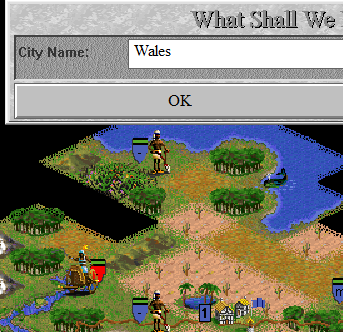
Well I’ve got another city to found and now I’ve got a plan.
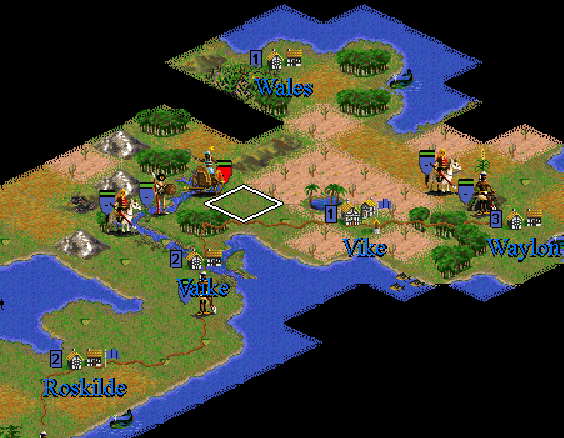
I mobilized everything I had available and also bought or switched to building some other countermeasures. The Chariot will massacre the Warrior- but outside the city, so no harm done. Then it will either stupidly leave itself exposed to an attack by my Horsemen or stupidly charge forward and then attack against a River and a Forest bonus at partial health and 2/3 Attack.
The odds are very good for me, but the chariot COULD still win either way. Resting easy with a plan that merely should work probabilistically and then blaming luck or scrambling to fix things when it goes wrong is playing badly. Each plan might be likely to work, but it’s almost certain one will fail, and it’s essential to accept that and be ready. By the time you implement any kind of plan in a game like this, you’d better have at least a backup plan ready to go and probably a backup backup plan.
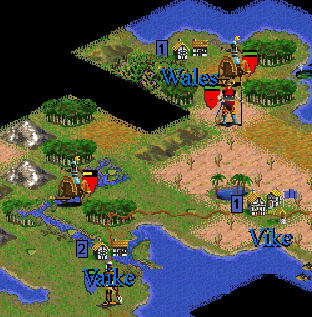
Alright, this went even worse than could reasonably be expected. The Charioteer didn’t just improbably beat the Horsemen despite all its disadvantages, it was barely scratched. AND another one popped up right next to my new city without warning. My backup plan was trashed, but I do have a backup backup ready.
The converse of needing to be prepared for bad luck is need to be ready to capitalize on any good luck. Like that exposed barbarian leader out there. That’s an opportunity to make some serious money at this point in the game.

First of all, I switched to produce a Horsemen in Vike last turn and rush-bought it because I knew that it would be able to ride out and finish the barbarian. You can see that once again I was tremendously unlucky- I took more than twice as much damage as I really should have and nearly lost. But that’s ok, because I still had another contingency ready if this attack failed.
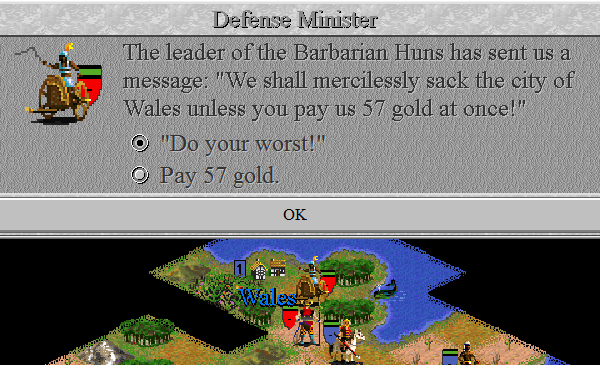
A tiny city like this that’s right near a bunch of available Settlers to re-found it if destroyed is definitely not worth that much gold.
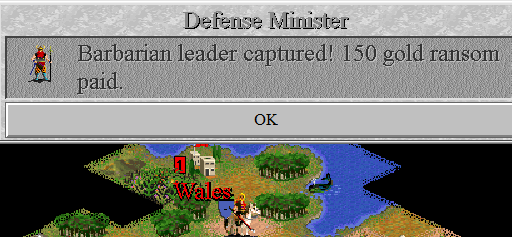
The other thing is that if I paid the barbarian off, he’d disappear. And I believe so would that barbarian leader, so I’d have lost another 150 gold. I’m already turning a profit on this barbarian attack and I’m not done yet. He took the city intact and that plays into my hands.
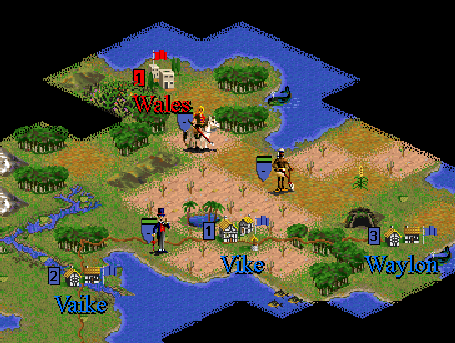
Ah, my backup backup backup plan is arriving.
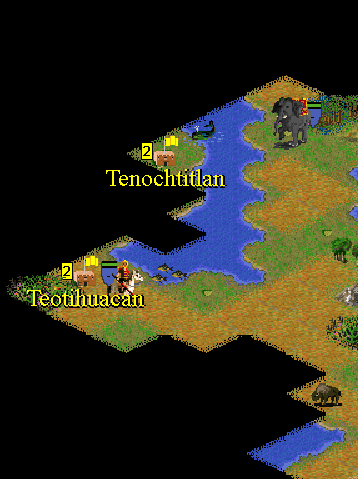
Found the Aztecs!
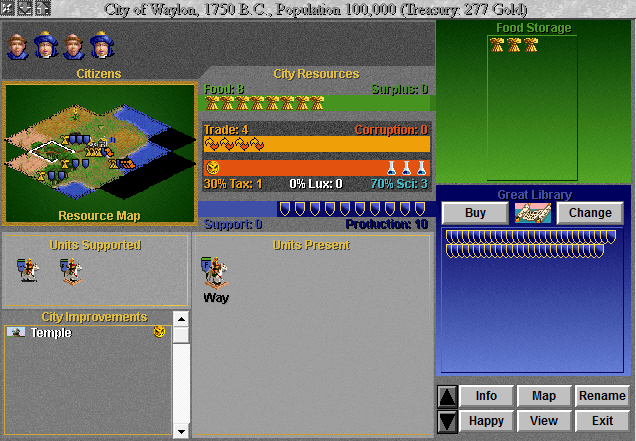
Waylon has been making good progress.
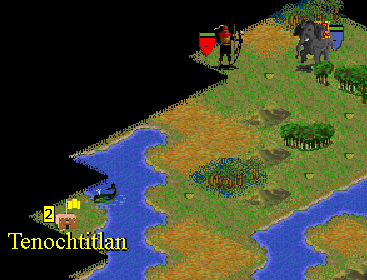
Hm. I could leave this Archer loose and he might hurt the Aztecs, or I could kill him and hope to get veteran status. I went for the latter, but it didn’t work. Oh well.
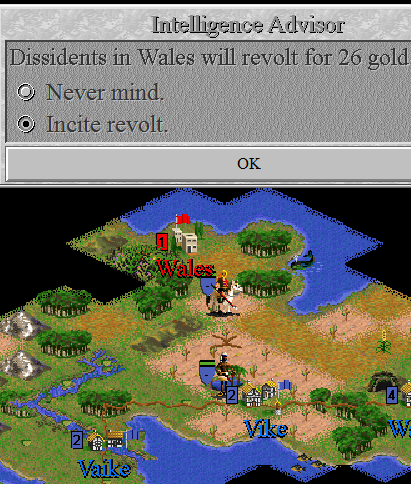
Ha! Now I get the Charioteer AND my city back for less than half what I was going to be charged for just the city.
In that barbarian incursion I lost a Horseman, a Warrior, a Diplomat, about 3 beakers worth of Science from not controlling Wales, about 30 gold finishing the Horseman and Diplomat, 26 gold buying the city, and a few turns’ worth of production in the city that produced them. I gained a Charioteer and 150 gold.
Net profit, and all because I was proactively preparing for things to go wrong rather than relying on one plan which bad luck foiled.
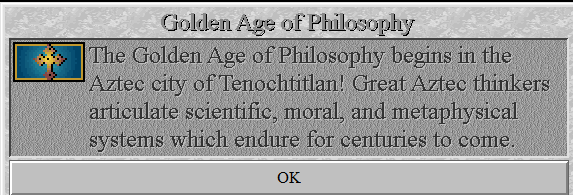
Darn, some more bad luck there. Philosophy just wasn’t offered in the last technology picking menu, so I was working on it now but could have finished it half a dozen turns ago. Oh well, not a big problem. I already have nearly all the techs I need, so missing out on a single bonus one is no big deal.
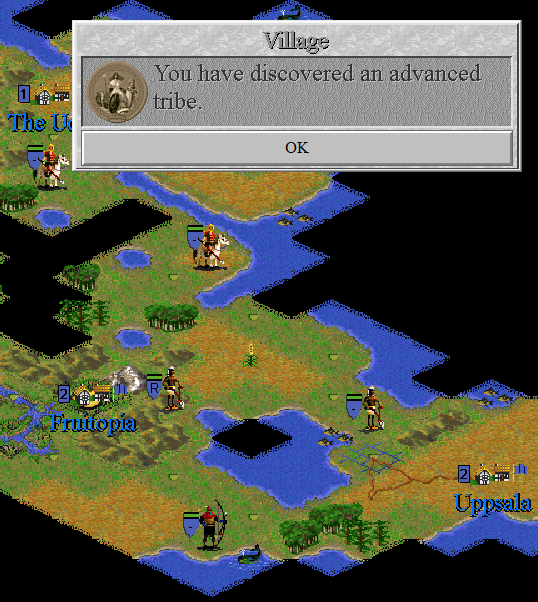
Sweet! As you can see, I finally have a decent number of scouts out and I’m beginning to get a much better view of the continent. The other thing to notice is that I’m quite close to having one unbroken road from Waylon to The Udal there.

It may be about time to gear up and take these scouts and crush the Aztecs. I just found a Legion here which should help a lot.
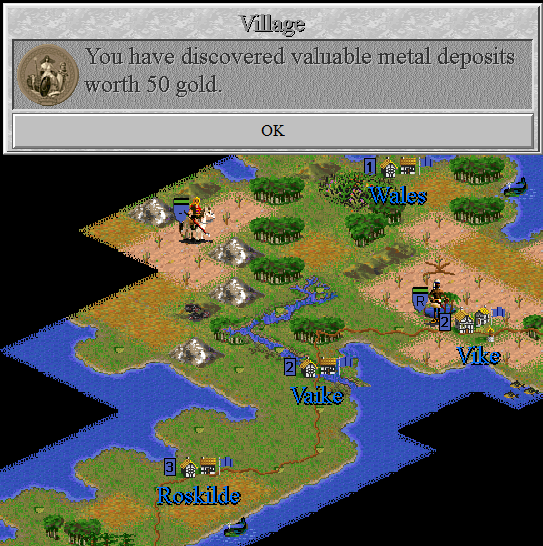
Not bad.
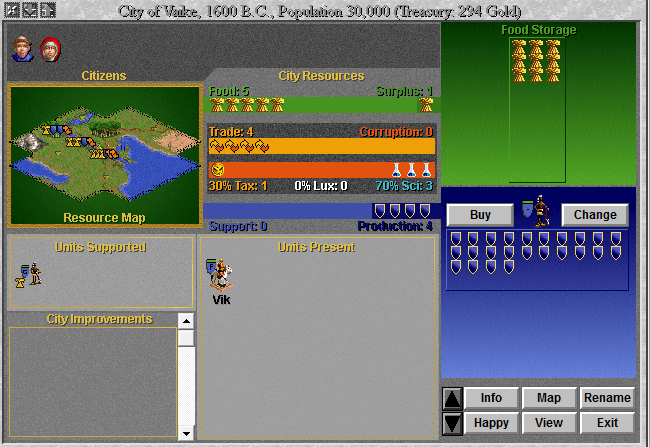
Some new city unhappiness here at last, but that’s easily dealt with.
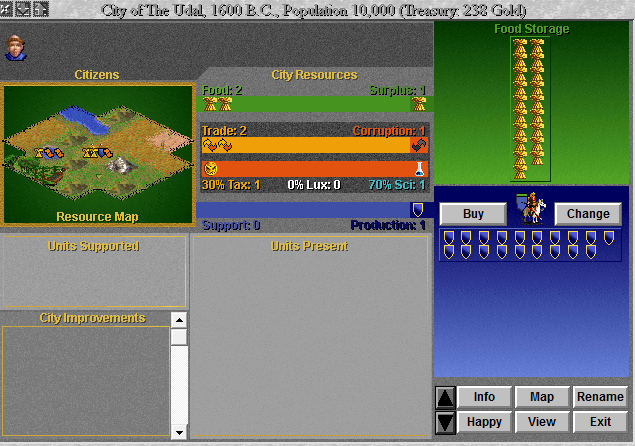
Corruption kind of spoils things, but I still get myself a free +1 gold here. It’s true that that’s not much, but getting in the habit of looking for and exploiting even the smallest opportunities makes you better able to spot and use the big ones.
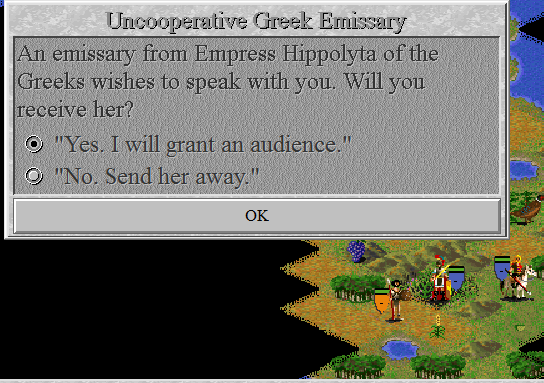
Interesting…
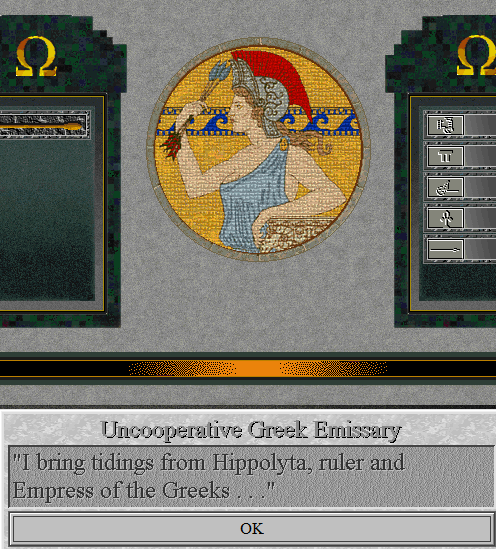
Ah, it’s not Alex this time.
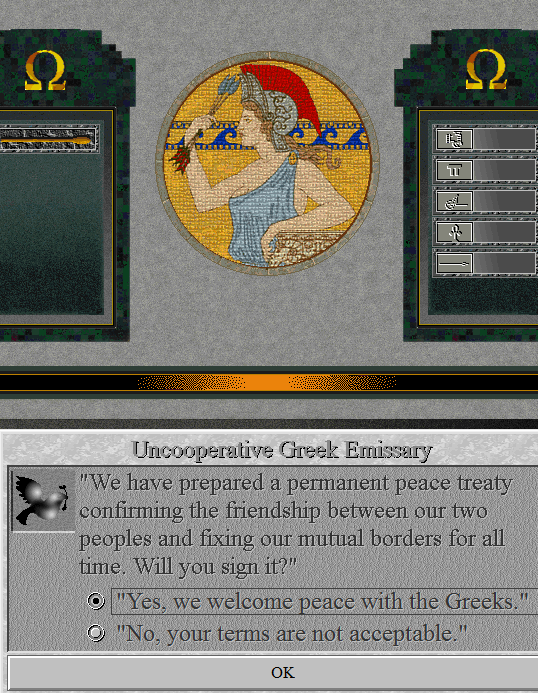
Sure, whatever.

What I need to do right now is lock down the borders with the Greeks and Aztecs to make sure that I have a complete stranglehold on my part of the continent to settle it as I please and only need to protect a small area to keep them out.
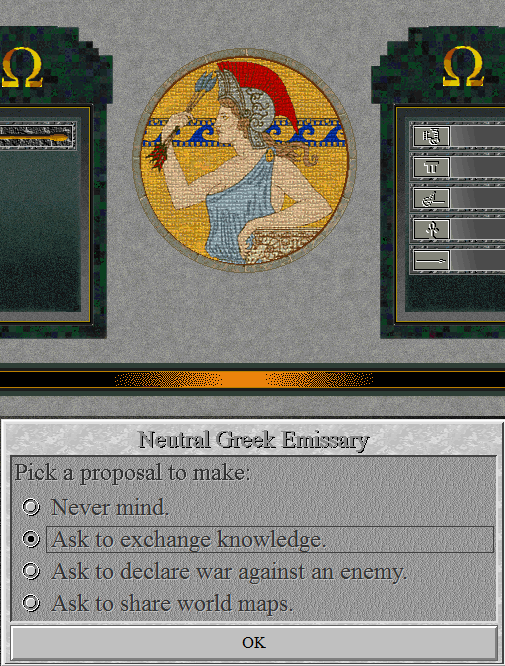
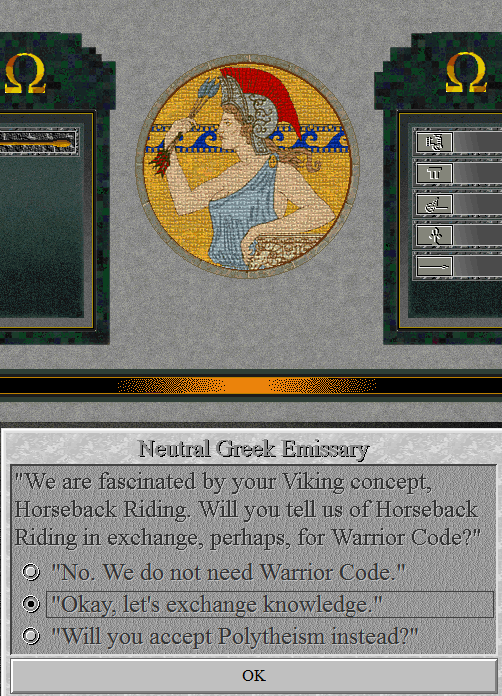
I can use Warrior Code. I’ll need that for Theology.
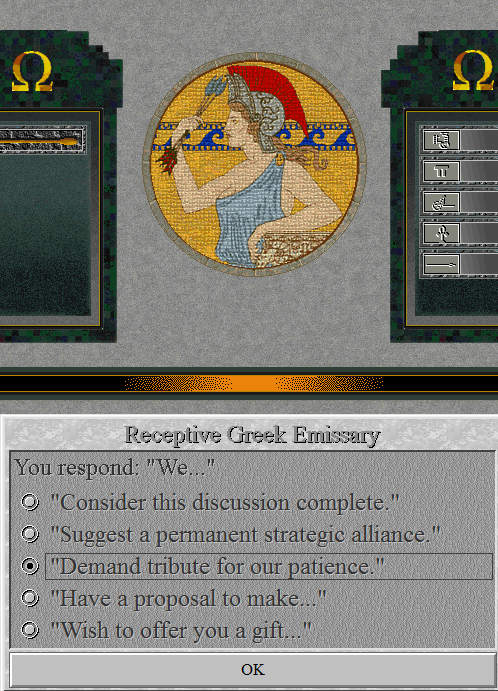
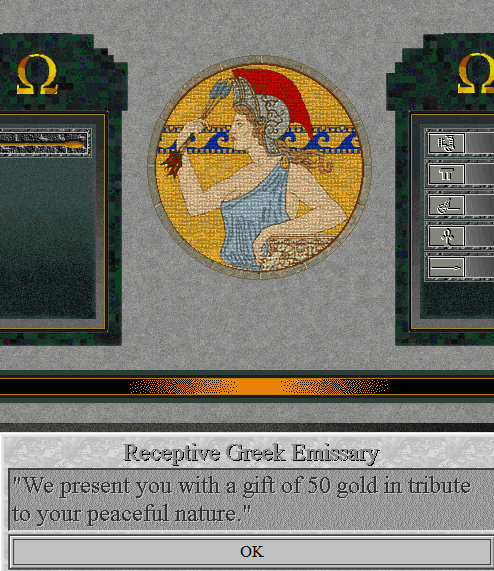
Yes, definitely very peaceful over here. Certainly no plans to conquer the world before 1500 AD.
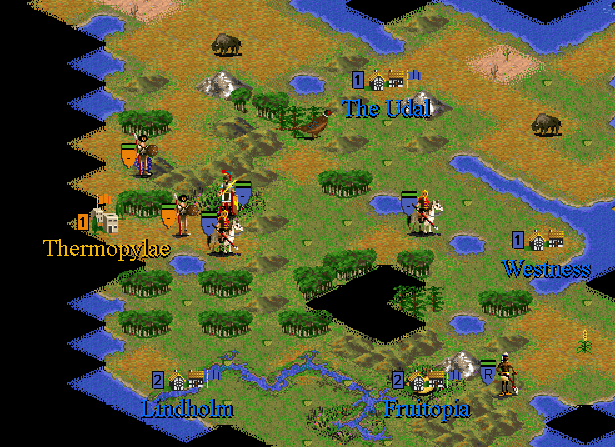
Containment time, I need to move into position so that my Zone of Control prevents her from moving her troops into my area. The trouble is that I’m currently restricted by HER Zone of Control, so I’ll need to kind of move my Legion in zigzags. And pull up all available other units to help.
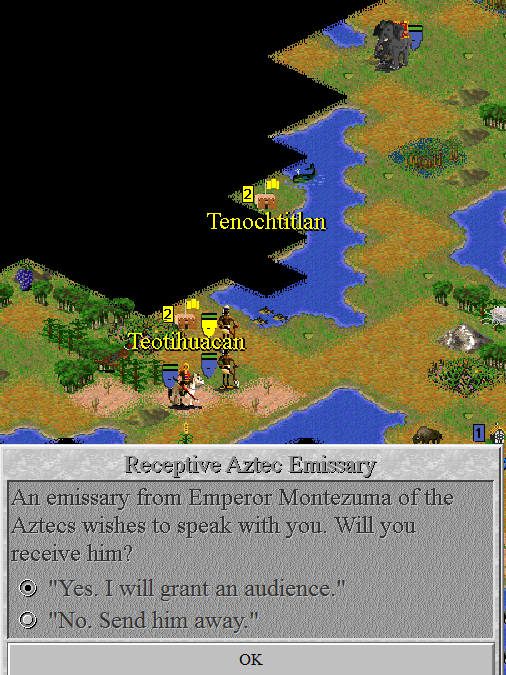
Things are a bit easier over here. I believe I’ve found the 1-2 points at which the Aztecs could conceivably enter my area and am now going to seal them off. Nothing really comes of these negotiations unfortunately, I just lower the Aztecs attitude demanding gold.
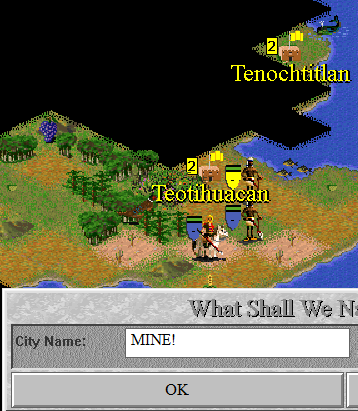
I'll need to fortify this place hard, but by building a city here I can screw with them by locking down all their great resource tiles. And it will let me restrain them by demanding they withdraw their forces from my territory (even though it's their territory too).
This will also make a good forward base to attack them from later.

Darn, that Archer slipped out of lockdown. I’ll have to build a Crusader or the like in The Udal and Viborg to stomp on it if it ever starts causing trouble.
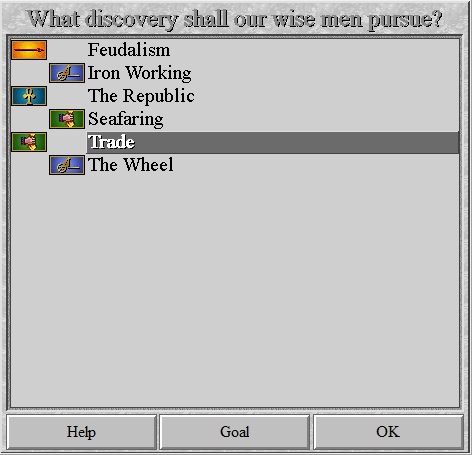
Yes, just unlocked Monotheism, Crusaders it is. Trade is nearly the last tech I need quickly.
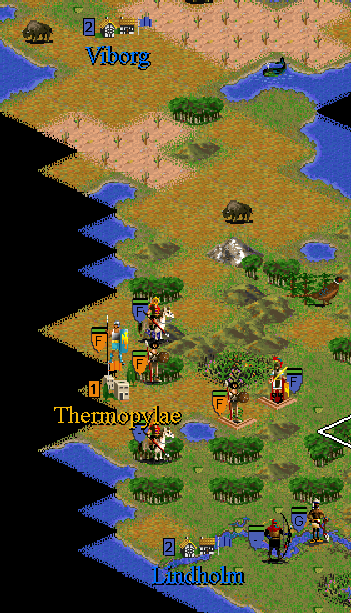
So I’m now in a good position and just about ready to start crushing the Greeks I believe. Time to start manipulating them into a war. The only wildcard is the missing Archer.
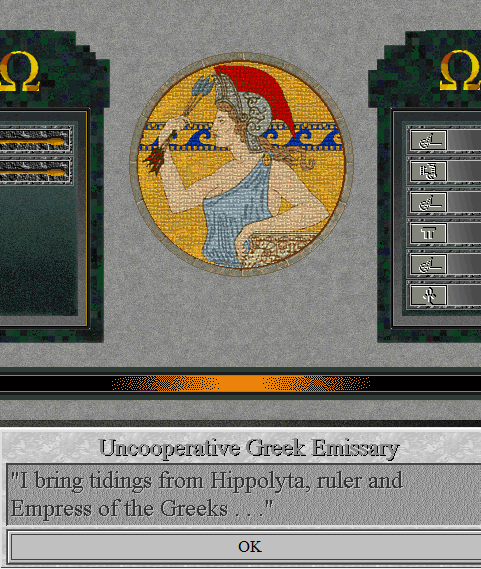
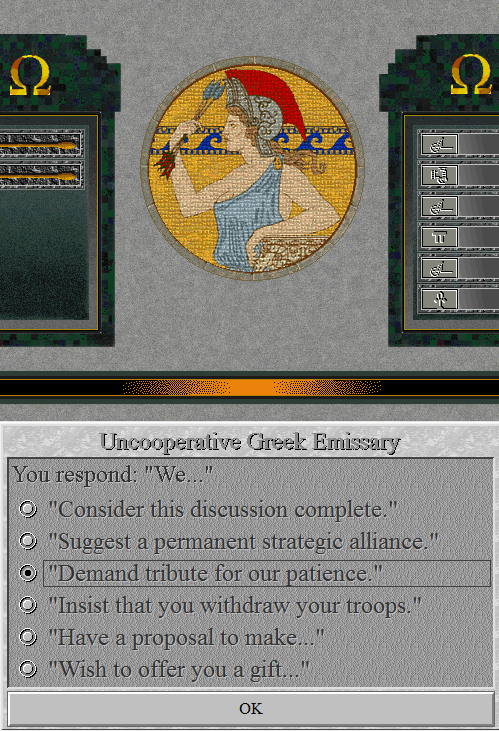
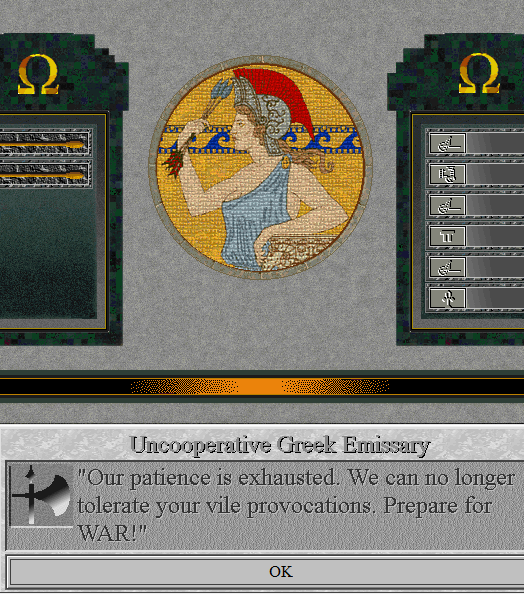
Sweet, alright. I was kind of hoping for one more turn and a bit more gold, but this will do nicely.
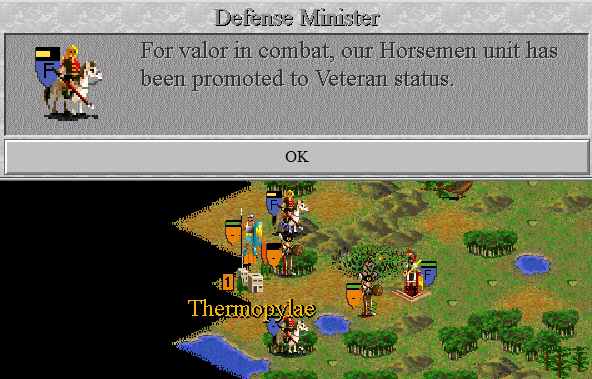
There we go.

Oh really?
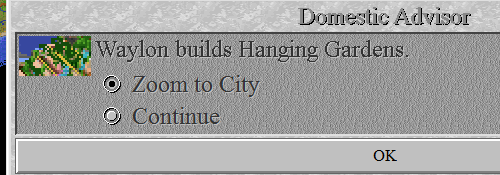
Denied!
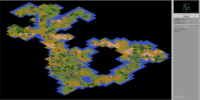
Alright, the first war starting and my first wonder finishing is a good time to end things.
I have 13 cities mostly in one long string down my weirdly shaped continent. That’s just slightly more than I had this many turns into the last game of course. Nearly all are now connected by a huge Road. This geographical issue is a fairly serious problem for me since it will make it really, really hard to quickly and efficiently conquer anyone. Even with my Road, it will take nearly 20 turns for a Crusader to walk from my capital to the current Aztec front.
I’ve got the Aztecs and the Greeks sealed in and thus have a free hand to keep expanding and settling across a gigantic, empty continent bigger than all the land in the last game.
Now that I have the Hanging Gardens to combat unhappiness from having too many cities, I’m finally free to start founding them in huge numbers. And I’d better do that too. There’s no time to waste and a ton of space to fill even if I ignore the mostly bad city sites. Even if I ignore the merely mediocre ones, in fact. So I’m going to need a lot of new city names. In particular, I want as many whale puns and references as people can come up with. Roskilde, Uppsala, Skara, Westness, The Udal, Lindholm, and Viborg are all awaiting names already.
I’ll also soon have Caravans (and I have many cities building dummy units like Crusaders which I can switch into caravans), so I can start mass-building wonders.
Yes, it’s a heady era in Viking history.